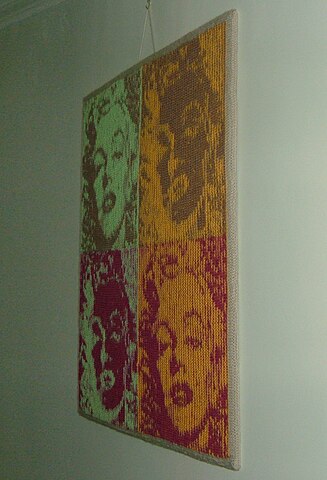
What Is Similarity?
Neurons in the brain respond to sensory inputs by firing impulses. The impulses establish patterns called IFPs (impulse firing patterns). These IFPs are equivalent to mental perceptions. If the playback of one set of IFPs is similar to another previous set of IFPs, then a person re-experiences a similar perception. That is recognition or simple memory recall. Questions arise. What is “similarity” among IFPs, and what conditions can cause similar IFPs?
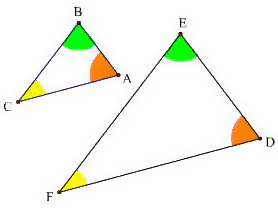
By PegasusRoe, Similar Triangles
First, what is similarity among IFPs? High school geometry states that two triangles are similar if their corresponding angles are equal in measure. For impulse firing patterns, angles are surely not the markers for similarity. What, then, are markers for similar IFPs?
Since IFPs are equivalent to MPs (mental perceptions), we can look at this in reverse. The markers we perceive from the senses should correspond to markers in IFPs. So we will look for markers that we can distinguish in perceptions, then use that to infer what markers are in IFPs. There are many examples of optical illusions where markers of similarity and dissimilarity are quite noticeable.

Figure A. Do You See a Triangle?
Figure A shows similarity to a triangle where no triangle is drawn. The contrast of light/darkness is the marker for the partial contour of a triangle. Children draw outlines of people, which are also markers of contrasts. The triangle figures we see in geometry textbook are just like children’s drawing. They show outlines that mark where contrasts lie.

By Wikistallion. Figure B. Do You See a Non-existent Border Along the Arrowheads?
Why does partial contour prompt us to perceive something that has a full contour? Perhaps our imagination automatically fills in the missing connections from the parts and make them whole. The mental processes connect the dots despite that no connections physically exist, as shown in figure B with an imaginary border. People perceive a full story out of disjointed movie chapters. It is just like we perceive that motion is continuous, but our eyes sampling positions of objects only at intervals, not continuously. Our imagination fills in the missing part and make the motion looks continuous.
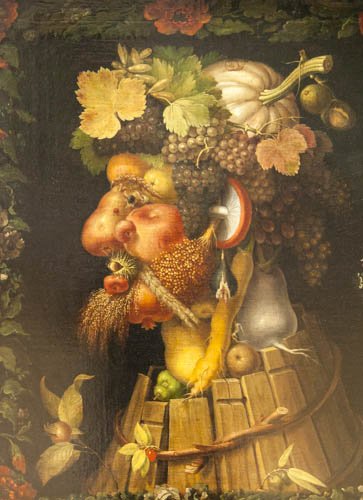
By Giuseppe Arcimboldo Figure C. Do You See an Organic Man?
Figure C shows a resemblance to a person. There are several markers in this composition that shows the features of a person. These markers are the relative sizes of the fruits / vegetables, colors, positions, and orientations.
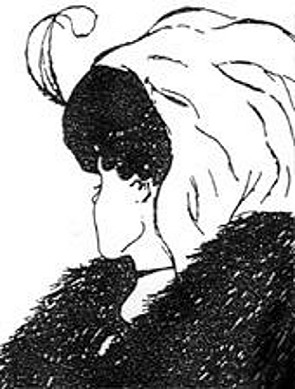
By W.E. Hill (1887-1962)
Figure D. Do You See a Young Or an Old Woman?
Figure D is similar to a young and an old woman at the same time. The marker here is the interpretation of context. It can be at the center of the figure, for example. If it is interpreted as an eye and a big nose, then the figure is similar to an old woman. If it is interpreted as the left ear and the cheek, then the figure resembles a young woman.

By Trocche100 at Italian Wikipedia - Transferred from it.wikipedia
Figure E. Do You See One Bar Longer Than The Other?
Figure E shows two bars of the same length but appear unequal. The marker here is again the context, the directions of the angled ends. Identical figures become dissimilar to each other by association with contexts. This happens not just with lengths, but sizes, colors, sounds, and meanings are all interdependent with contexts.
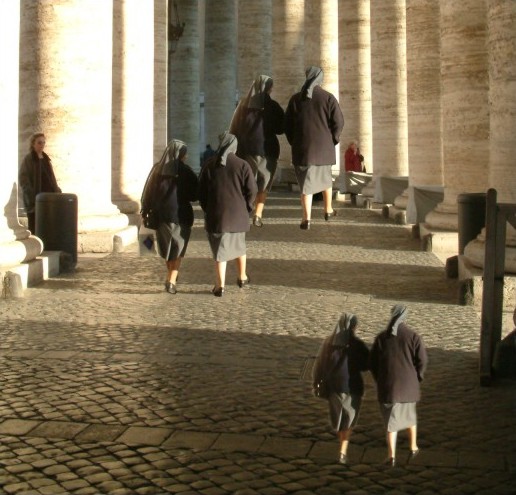
By Anton at the German language Wikipedia
Figure F. Apparent Size Is Relative To the Context.
In figure F the pairs of nuns look different in sizes in the context of the corridor. They are equal in sizes in the context of measuring rulers.
Video 1. Color Illusion
Video 1. Different backgrounds surrounding the color areas make them look different. It is the contrast to contexts that creates the color illusion.
Video 2. Audio Illusion
Video 2. The sound one utters, combined with the visual cues of mouth movements, make the outcome sounds different.
The sound one utters, combined with the visual cues of mouth movements, make the outcome sounds different. Puns are a form of jokes. Its punch line comes from the clever switching of meanings in context. For example, “I wondered why the baseball was getting bigger. Then it hit me.” The context “it hit me” can mean literally that one gets hit by the ball, and it can also mean idiomatically that one understands why the ball was getting bigger.
Video 3. Relative Sizes In the Context of a Room
Video 3. By clever arrangements, objects of abnormal sizes can be contrasted to the context (the room) to appear normal in sizes.
From these examples, we see that perceptual markers lie in where contrasts or changes take place. Also, context or environmental background can fundamentally alter contrasts because contexts are that which surround the text and contrast the text. Since markers in MPs (mental perceptions) correspond to markers in IFPs (impulse firing patterns), we predict that IFP markers also lie in where contrasts and changes are. What might be contexts for IFPs? Likely they are the impulse firing threshold, timing, the synaptic connections, the composition of surrounding neurochemicals, the sensory stimulus inputs, and the various IFPs themselves. It all has something to do with differences. Just as Gregory Bateson has defined it, information is a difference that makes a difference.
Video 4. Stroboscopic Effect. Motion Illusion.
Perception of motion is another example of differences inside and outside (the difference between object and context). In video 4, the wheel spokes of the car can seemingly turn backward. What is the reason behind this illusion? It lies in the timing of IFPs. The marker of motion comes from the spokes being in different positions at different times. This marker can be subjected to the stroboscopic effect. Movies are motion pictures because of this effect. The stroboscopic effect is due to the limit of how fast the optical IFPs can fire. The rate of firing is the visual sampling rate where positions of the wheel spokes are registered. The timing of changes in the spoke positions (timing 1) relative to the timing of the eyes’ nerve impulse firings (timing 2) can result in different kinds of appearance: 1) the spokes turning forward, 2) the spokes staying still, 3) the spokes turning backward, and 4) the spokes look blurred. This is known elsewhere as the Moire effect.
Video 5. Moire Effect
Video 5 shows a Moire pattern effect. Patterns on the lower sheets exemplify change of positions of some objects, while the pattern on the upper sheet exemplifies the timing of letting the under-sheets show through. That upper sheet effectively provides a stroboscopic effect, like the eyes firing impulses to register visuals at sampling intervals. The movement of the upper sheet over the lower sheets creates illusory motions. This effect, due to the relative timing of the recording sampling rate, and the rate of object’s positional changes creates a vision of “motion” that can move either forward or backward. That is the reason how the wheel spokes in video 4 appear to turn forward or backward.
Anyway, “markers” of IFPs are basically some kinds of difference or relationship. We may measure how such markers can quantify similarity. Suppose that there are two sets of IFPs with 10 markers each. If arbitrarily 5 or more markers of the 10 are the same, and the two sets of IFPs correspond to perceptions that are similar, then we can say that similarity happens when two IFPs share 50% or more identical markers. However, this is an arbitrary designation for similarity. Whether similarity can be qualified by such a ratio is unknown. It is to be investigated by those who are interested.
Languages can be a good field to test similarity. There are plenty of data readily available for analysis. Analogies, similes, metaphors, parables, fables, allegories, translation of words / phrases between languages, are all ripe for similarity analysis. Whatever similarity is, it must come from relationships between the text and the context, something in between the lines. Here is a quote from a Chinese tv show: “We are investigating corruption charges for our emperor; not a grain of sand is allowed in the eyes.” People naturally understands the sand metaphor. The last sentence is similar to saying the investigation can not have any blemish or something like that.
Markers of differences can have different logical types: differences in positions and differences in timing are one type, but the difference between positions and timings is another type. The two types are of different logical orders. This logical typing of differences is studied in great depth by Gregory Bateson. He pointed out that without keeping track of logical typings, scientific reasonings could easily become mumble jumbles It would be like comparing apples to oranges, mind to energies, or a class member to the whole class.
Anyway, so far we have looked at similarity through examples of sensory illusion. Similarity is the “difference” that triggers cognitions to replay as simple memories, informationally speaking. From the replay of similar IFPs we get recognition. Next, we will look at conditions that can induce playbacks of similar IFPs at will. They make recognition repeatable and precise. It is sometimes called muscle memory. It enables actions like pronouncing sounds of language, fingering instruments of music, or adding and subtracting. It can also be called objective memory or sequential memory because it is formed by repeating same sequential movements over and over until it is rigid and precise and objective-like. We will see how adaptations of neural circuitry to repeating stimuli accomplish this.
No comments:
Post a Comment